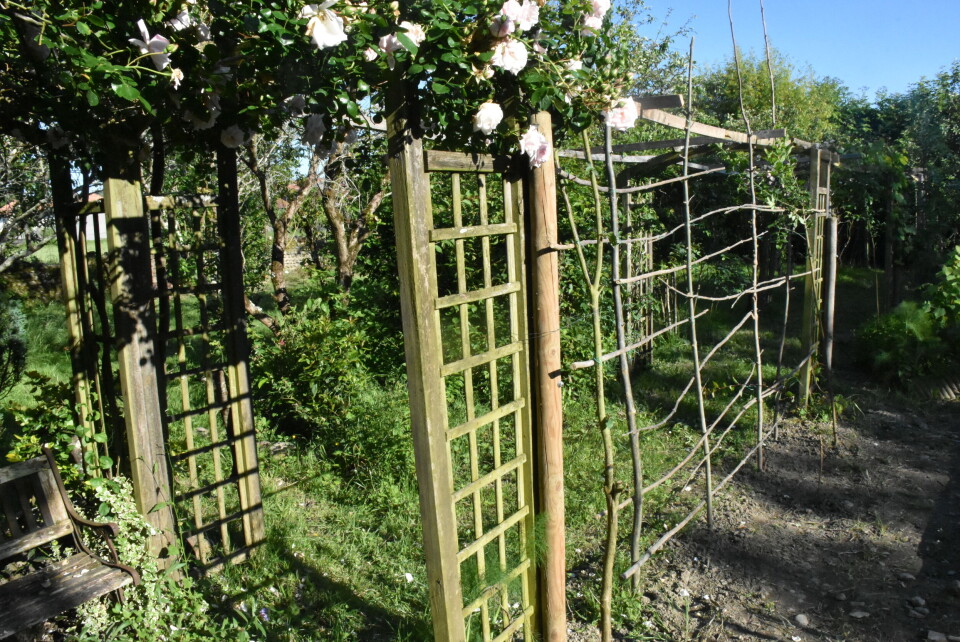-
France’s wild garlic season is here – but foragers should beware toxic lookalikes
Spring brings the fragrant plant to woodlands nationwide. We explain what to look out for
-
Let your lawn grow, water for birds: how to help wildlife in your French garden
‘It is acceptable to have untidy hedgerows,’ says biodiversity spokesperson.
-
How to help hedgehogs in your garden in France
Follow these tips to create a healthy ecosystem for this protected species
French DIY: My mission to build a cost-effective garden pergola
After losing his box hedge to caterpillars, Nick Inman attempts to revive his garden by taking on the challenge of a DIY pergola

As the weather warms up, my urge to make things move outdoors, even though my wife says this is not “proper DIY”.
I know the garden is not a priority when there is so much to do around the house and the outbuildings, but there was a project I wanted to complete.
Between the path leading to the bottom of the garden and the vegetable patch, we used to have a beautiful box hedge.
It grew slowly year on year until, one summer, the caterpillars got at it and soon there was not a leaf left.
I had to dig the whole thing up, leaving a long, ugly bare line of earth.
In its place, I decided to build a pergola covering the path.
The easy option would have been to buy a ready-made structure but one stretching for 20m would have been more than I could afford.
Instead, I decided to improvise and, at the same time, make it more organic.
I started with some cheap and flimsy bits of pergola that I had bought on promotion from a supermarket a few years ago.
I decided to rely on nature rather than spending money
I had to reinforce them with poles, treated for rot, but still these elements were too spread out and looked pathetic.
Rather than spend money, I decided to let nature supply me with the materials.
Where we live, ash trees shoot up as weeds in the flowerbeds.
For the last few winters, I have been transplanting them to the border of our property, where they grow at a prodig-ious rate until I feel like coppicing them, ie. lopping the tall and slender tips off.
These ash shoots, one or two metres long, were just what I needed to join the uprights.
I interwove them as much as I could and used wire recycled from my journalist’s spiral notepads to fix them in place.
The result was a very irregular trellis running down both sides of the pergola.
For the last few years, I have been training whatever plants I can – a vine, a passion flower, a honeysuckle, etc – to climb up this trellis, and the whole thing has slowly grown into an idiosyncratic feature.
The ash switches will rot but there are always more growing out of the hedge and I will
harvest them as needed to repair my pergola.
Truly sustainable building.
Vine experiment
Last winter, I decided to experiment with a different kind of natural garden structure.
I have a vine which does not produce grapes for either wine or the table, but which grows faster than seems possible.
I wondered whether it would be possible to train it to cross overhead from a wall to an outbuilding – a span of over 2m.
I have always wanted to work with bamboo, so I asked a friend if I could cut some very long lengths of black canes he had growing at the bottom of his garden. With these, I fashioned an arch – bamboo will bend only so much if you are careful, but even if it snaps, you can still make interesting shapes out of it.
Bamboo is also easy to drill through and I was able to fix the key sections together with thin lengths of threaded bar and nuts.
The two ends of my bamboo vine bridge, I realised, needed reinforcing with sturdy uprights. For this, I used two pieces of timber that used to form part of my pigeonnier roof.
They must be a good 100 years old and, while their outer layers are eaten away, the heartwood has not rotted at all.
The result is a vine-carrying arch crossing from one part of the garden to another.
I know it is not as vital as all the other jobs that need doing but what is the point of DIY if you cannot sometimes make something that gives you pleasure to look at?
Related articles
French farmhouse renovation unearths tools that tell everyday history
French farmhouse renovation: Installing a gable window
French farmhouse renovation: Turning a rubble pile into garden feature
























